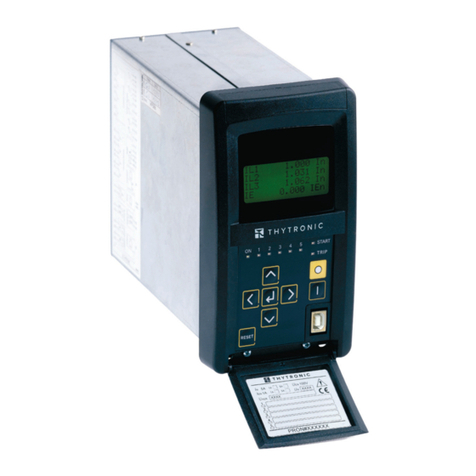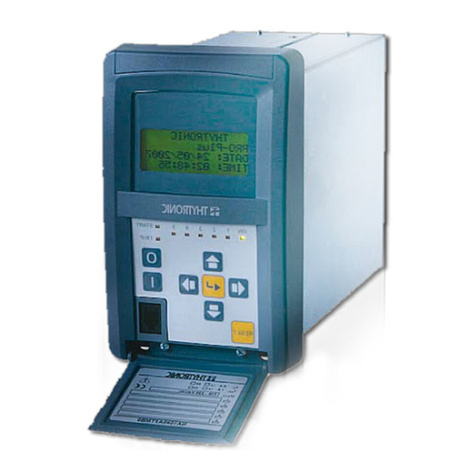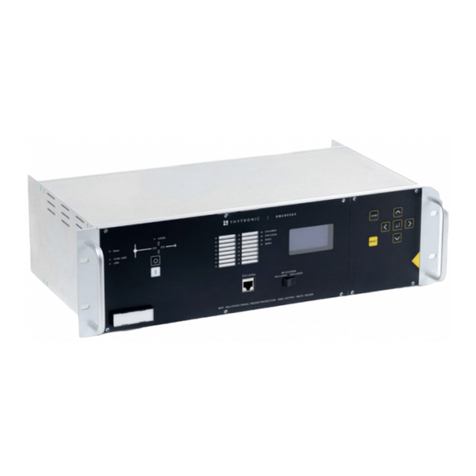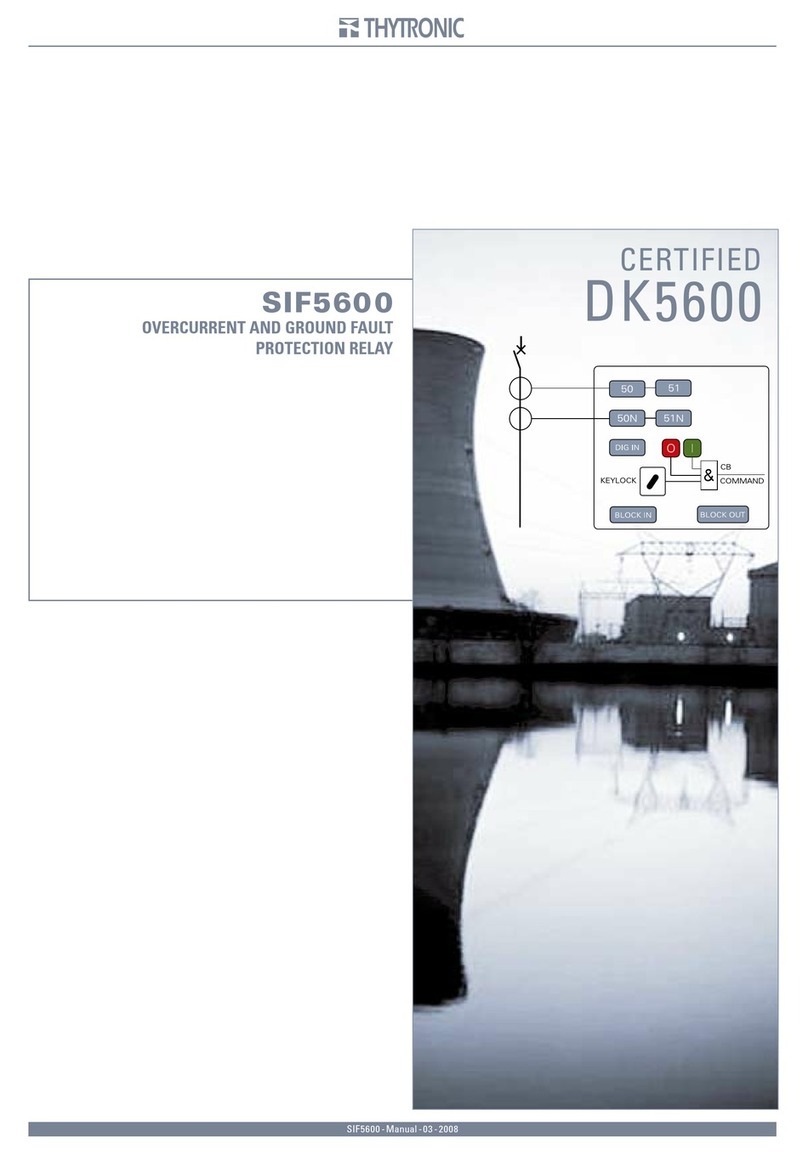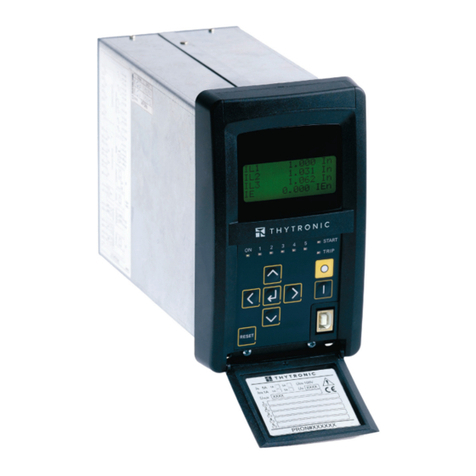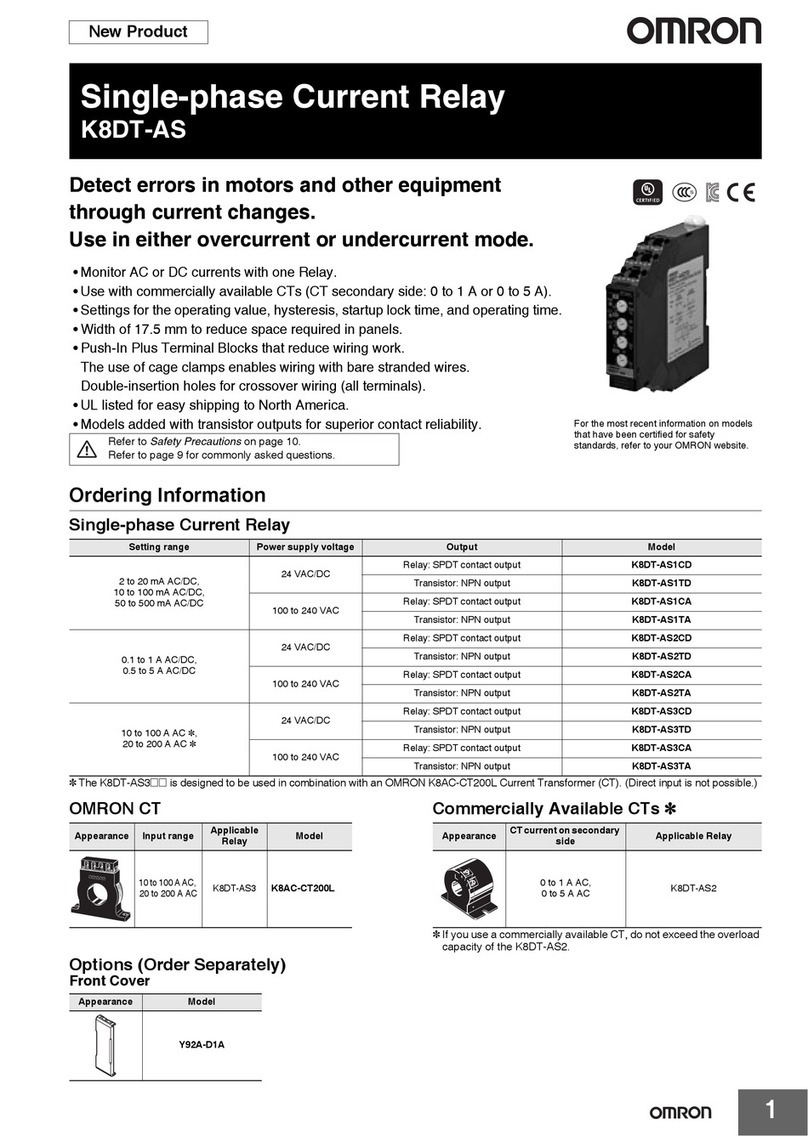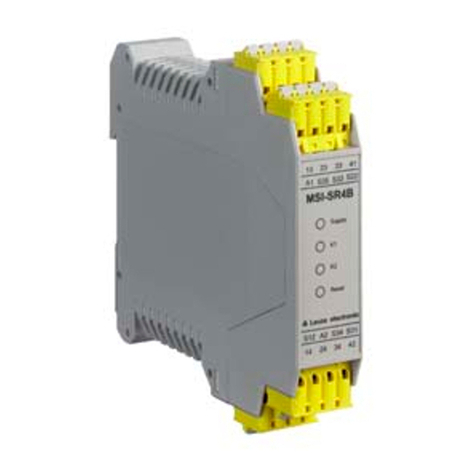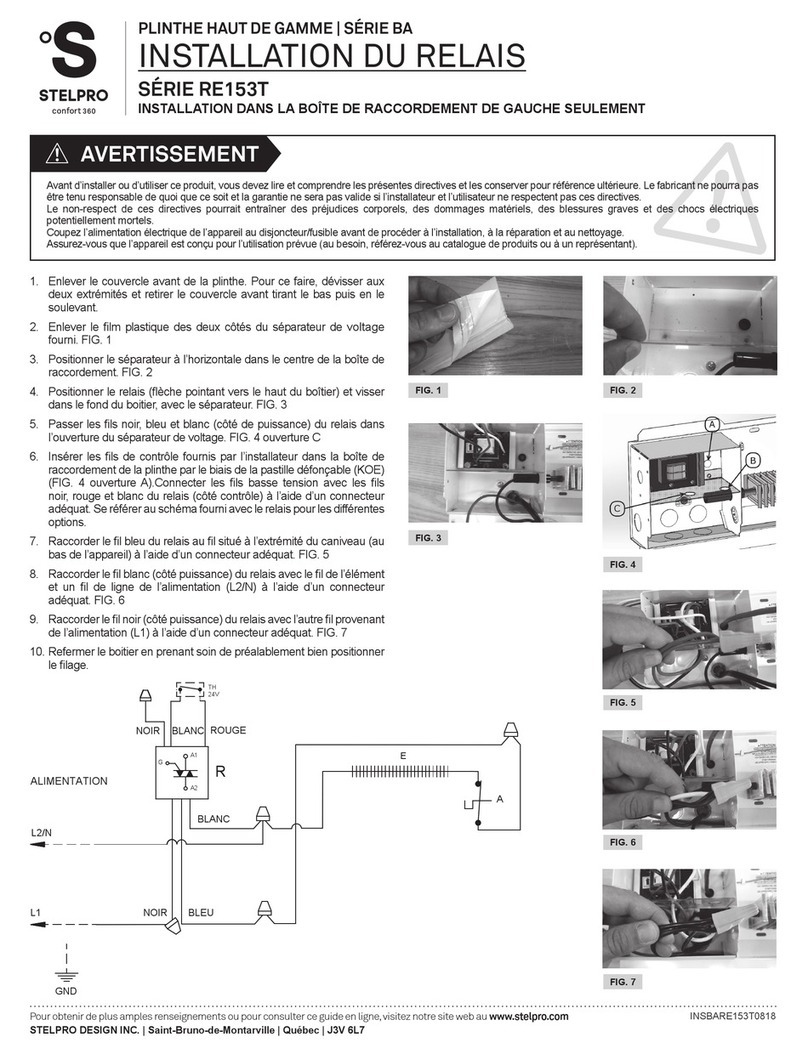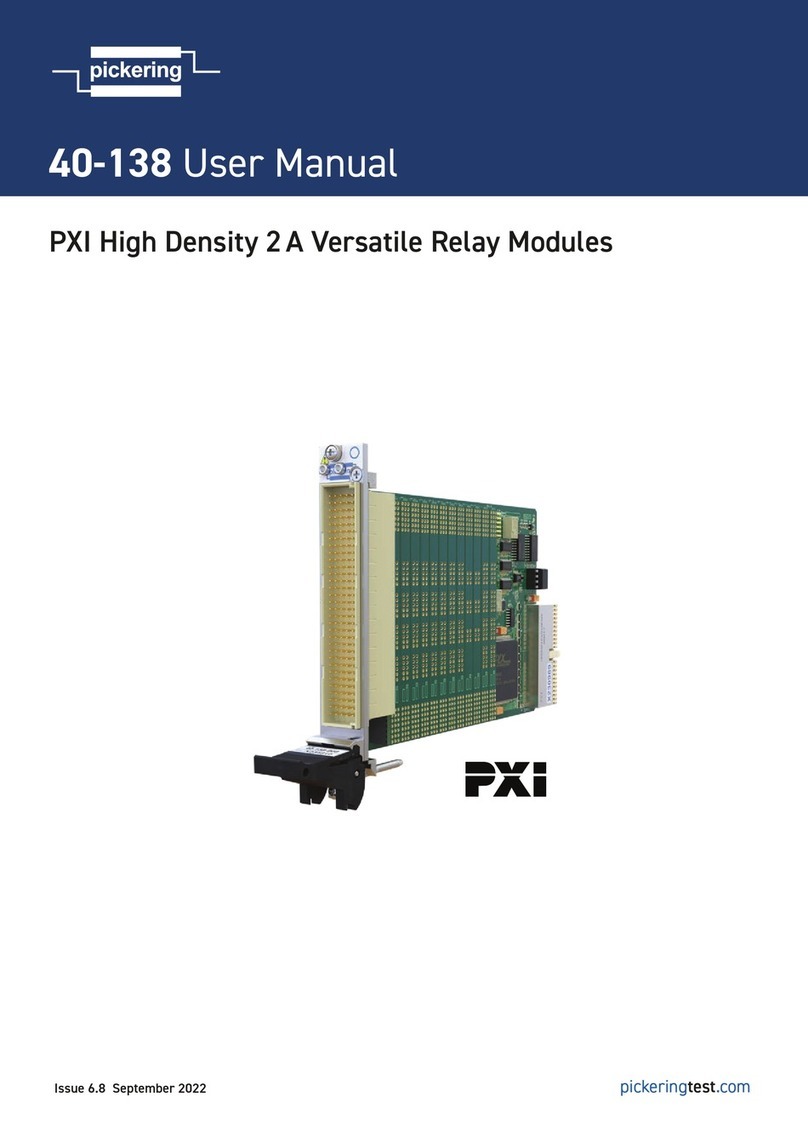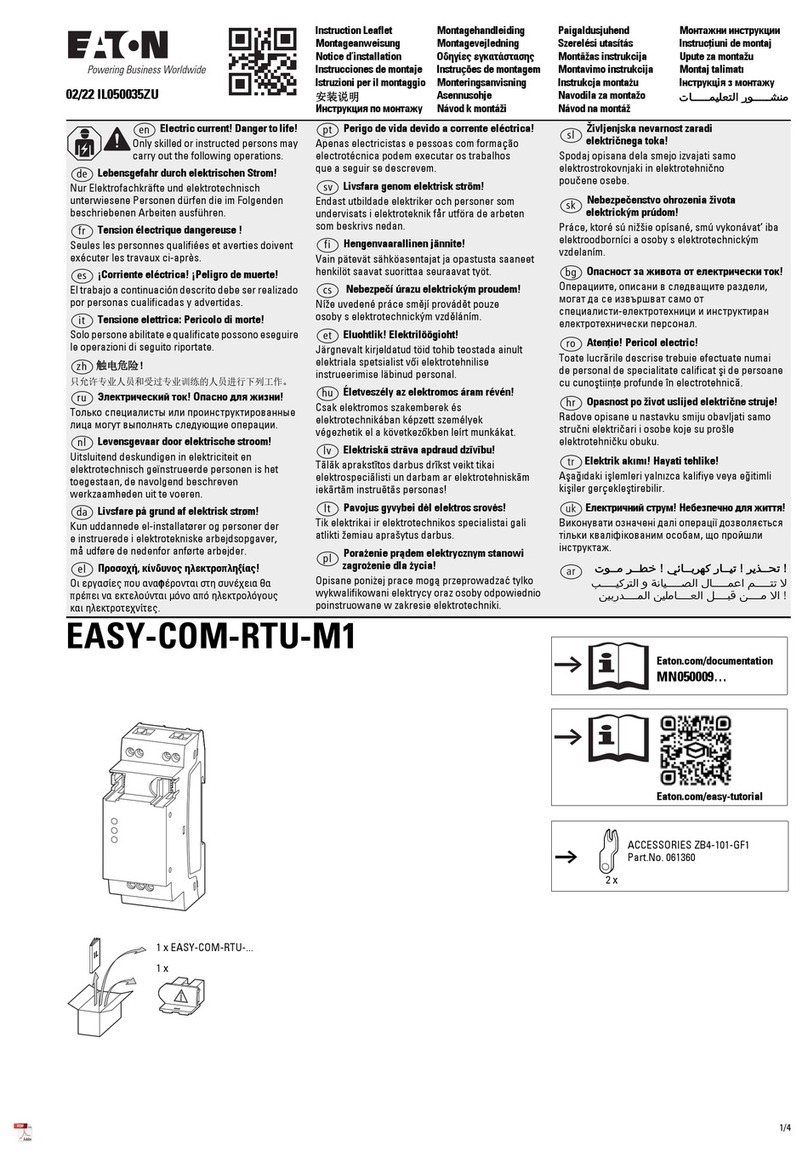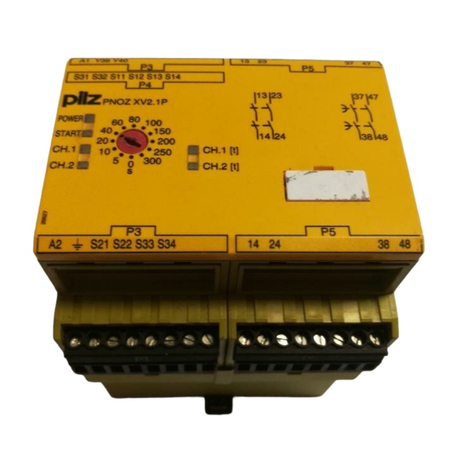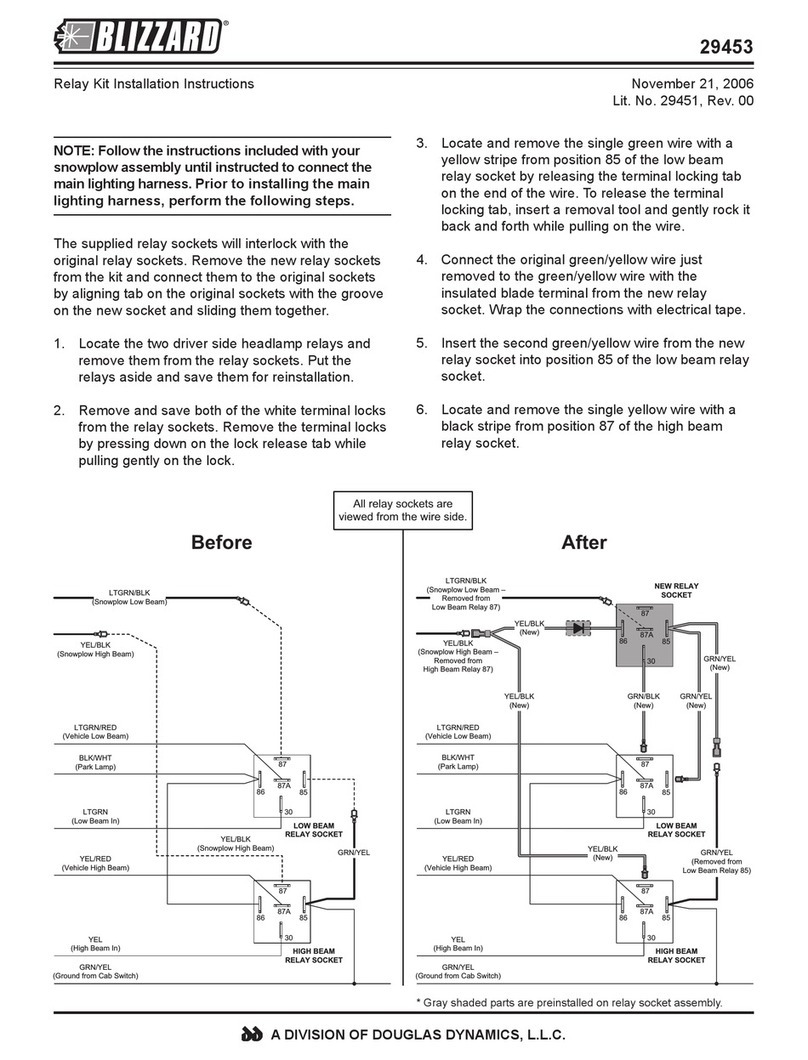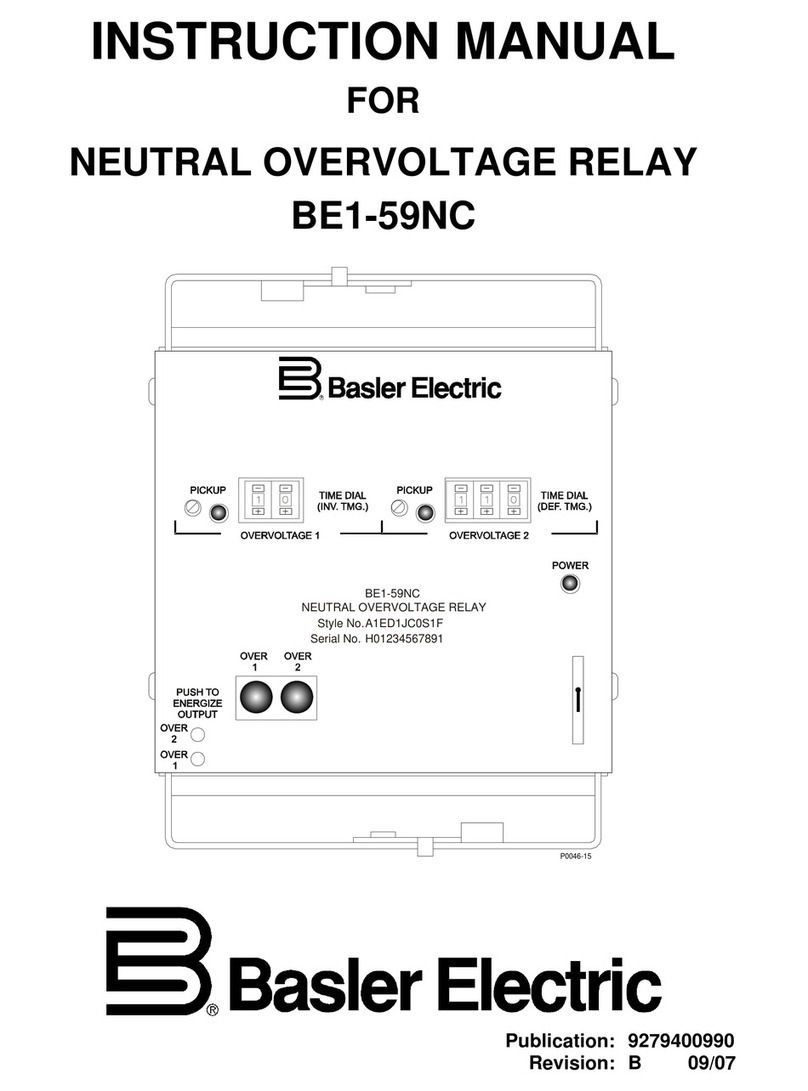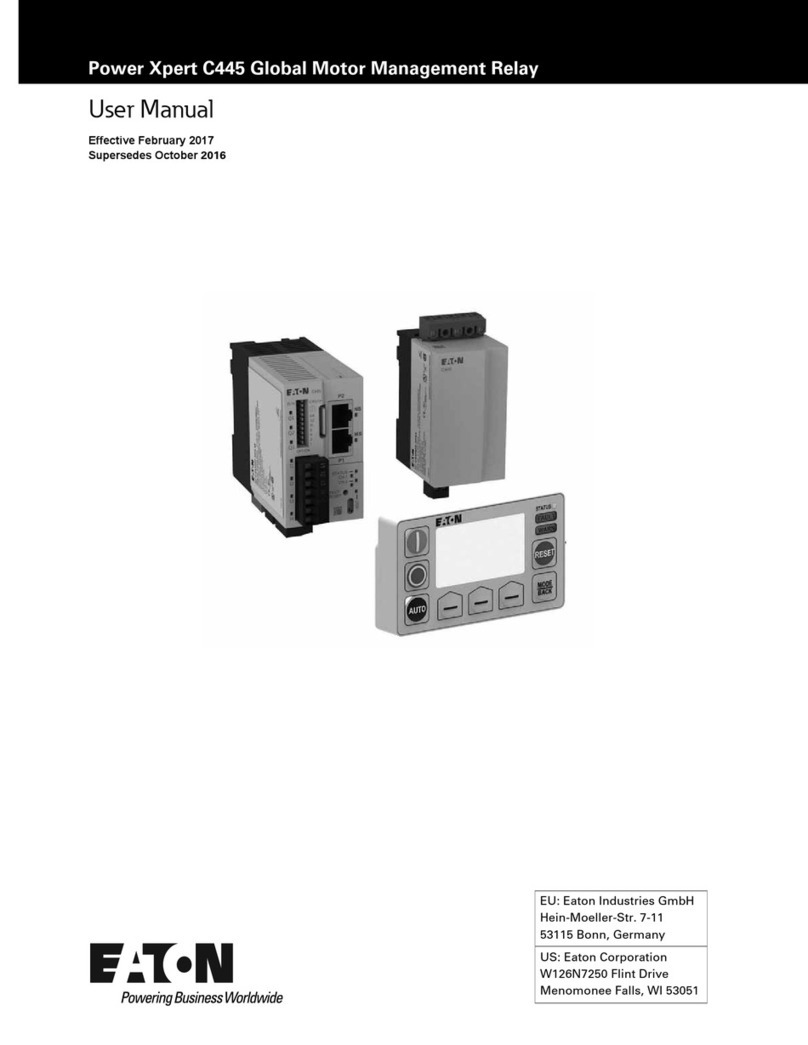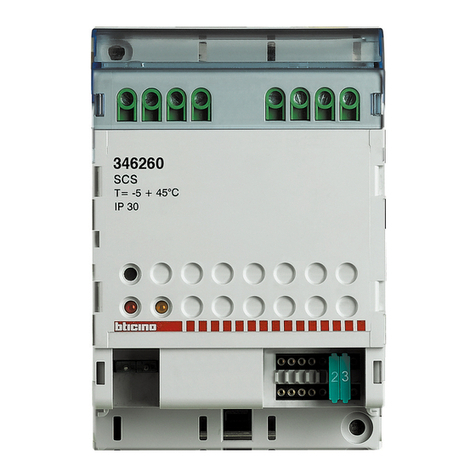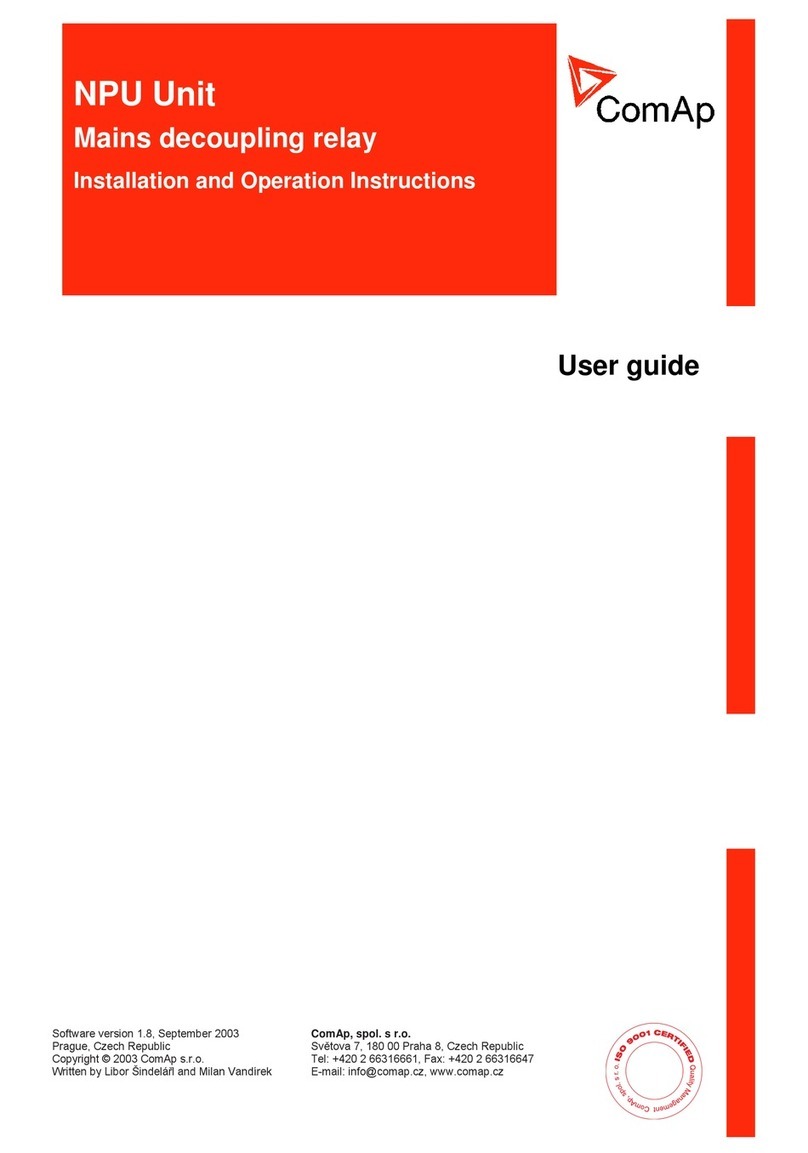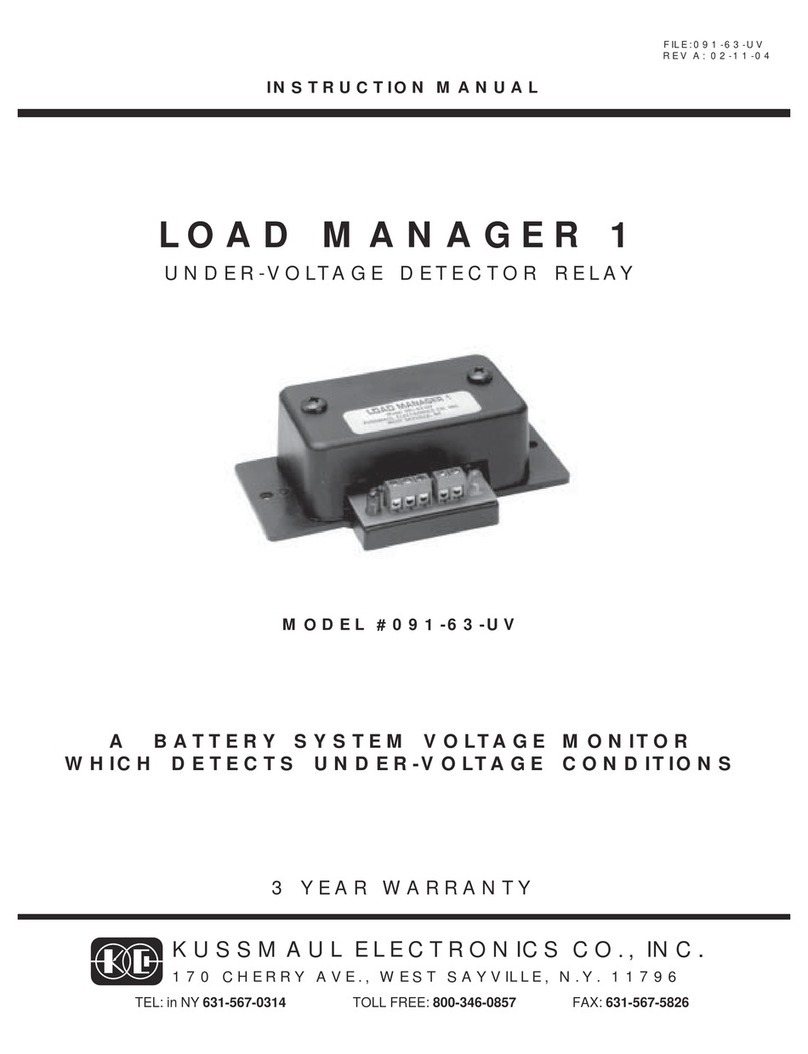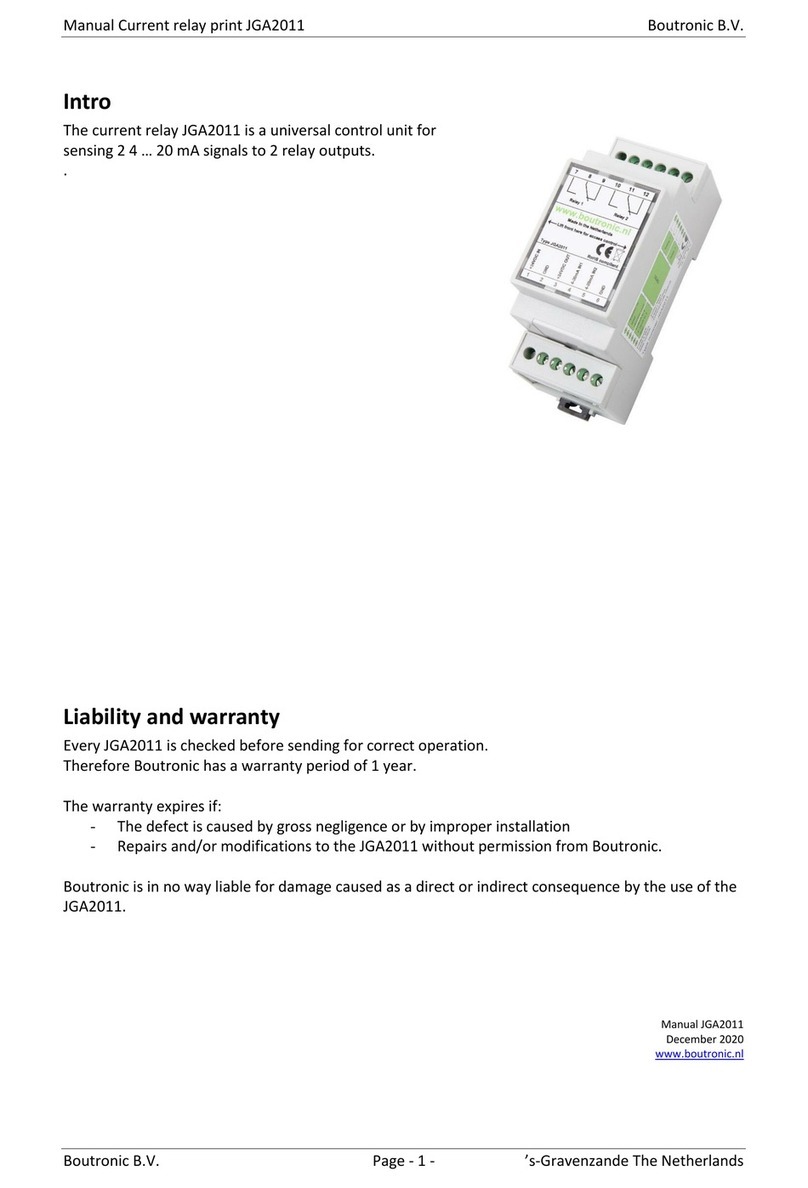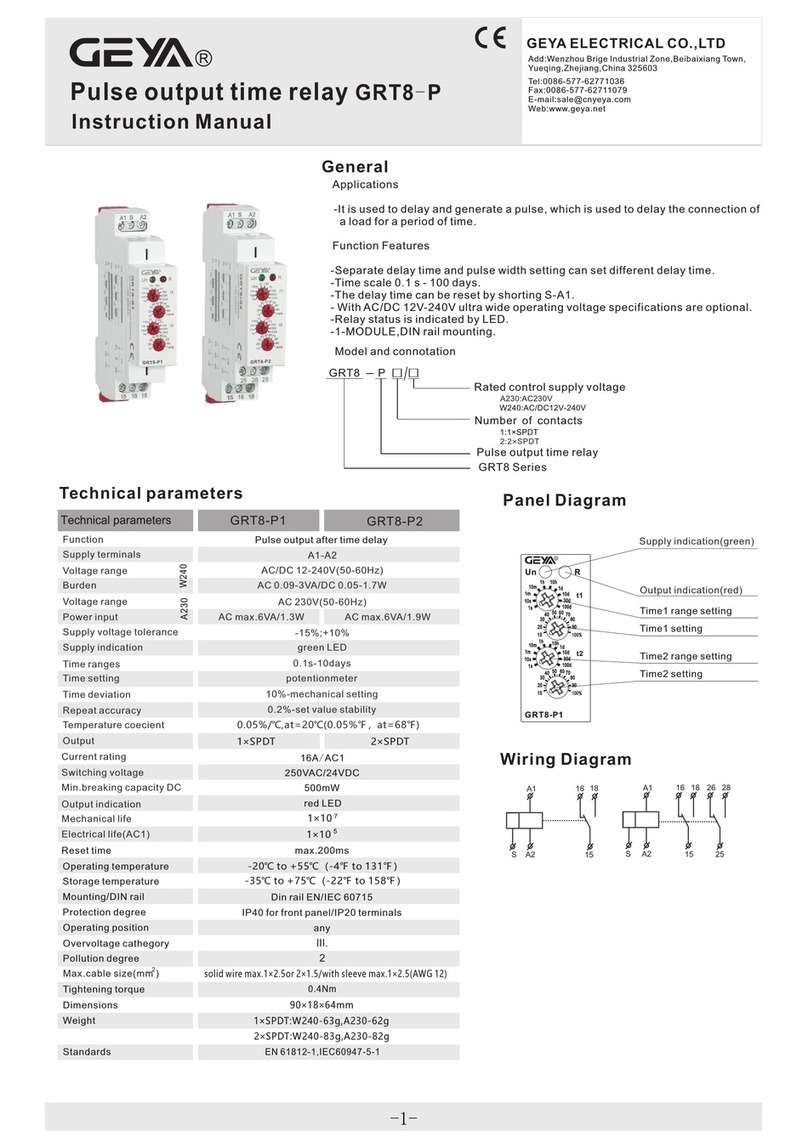Thytronic NV10B User manual

NV10B - Manual - 04 - 2022
MANUAL
NV10B
MULTIFUNCTION VOLTAGE AND FREQUENCY
PROTECTION RELAY

2
NV10B - Manual - 04 - 2022
TABLE OF CONTENTSTABLE OF CONTENTS
1 INTRODUCTION 5
Scope and liability...........................................................................................................................................................................................5
Applicability......................................................................................................................................................................................................5
Conformity ........................................................................................................................................................................................................5
Technical support............................................................................................................................................................................................5
Copyright...........................................................................................................................................................................................................5
Warranty...........................................................................................................................................................................................................5
Safety recommendations...............................................................................................................................................................................5
Insulation tests ................................................................................................................................................................................................5
Product identification.....................................................................................................................................................................................6
Environment .....................................................................................................................................................................................................6
Graphical conventions ...................................................................................................................................................................................6
Glossary/definitions........................................................................................................................................................................................6
2 GENERAL 10
Preface........................................................................................................................................................................................................... 10
Main features................................................................................................................................................................................................ 10
Photo ...............................................................................................................................................................................................................11
3 TECHNICAL DATA 12
3.1 GENERAL............................................................................................................................................................................................................12
Product standard for measuring relays.....................................................................................................................................................12
Mechanical data ...........................................................................................................................................................................................12
Insulation ........................................................................................................................................................................................................12
Voltage dip and interruption........................................................................................................................................................................12
EMC tests for interference immunity.........................................................................................................................................................12
Emission......................................................................................................................................................................................................... 13
Mechanical tests.......................................................................................................................................................................................... 13
Climatic tests................................................................................................................................................................................................. 13
Safety ............................................................................................................................................................................................................. 13
Certifications................................................................................................................................................................................................. 13
3.2 INPUT CIRCUITS ...............................................................................................................................................................................................14
Auxiliary power supply Uaux ......................................................................................................................................................................14
Voltage input circuits....................................................................................................................................................................................14
Residual voltage input circuit......................................................................................................................................................................14
Binary input circuits......................................................................................................................................................................................14
3.3 OUTPUT CIRCUITS............................................................................................................................................................................................14
Relays..............................................................................................................................................................................................................14
3.4 MMI.....................................................................................................................................................................................................................14
3.5 COMMUNICATION INTERFACES ...................................................................................................................................................................15
Local port........................................................................................................................................................................................................15
Remote ports..................................................................................................................................................................................................15
3.6 GENERAL SETTINGS ........................................................................................................................................................................................16
3.7 PROTECTIVE FUNCTIONS ...............................................................................................................................................................................16
Thermal protection with Pt100 probes - 26 ...............................................................................................................................................16
Undervoltage - 27..........................................................................................................................................................................................16
Overvoltage - 59.............................................................................................................................................................................................16
Residual overvoltage - 59N..........................................................................................................................................................................17
Breaker failure - BF.......................................................................................................................................................................................17
3.8 CONTROL AND MONITORING....................................................................................................................................................................... 18
Trip Circuit Supervision - 74TCS................................................................................................................................................................. 18
Circuit Breaker supervision........................................................................................................................................................................ 18
Oscillography (DFR) ..................................................................................................................................................................................... 18
PLC (Programmable Logic Controller) ...................................................................................................................................................... 18
3.9 METERING......................................................................................................................................................................................................... 19
Accuracy (type tests)................................................................................................................................................................................... 19
Measures....................................................................................................................................................................................................... 19
4 FUNCTION CHARACTERISTICS 20
4.1 HARDWARE DESCRIPTION............................................................................................................................................................................ 20
Power supply board......................................................................................................................................................................................21
CPU board.......................................................................................................................................................................................................21
Input board.....................................................................................................................................................................................................21
MMI (keyboard, LED and display) ..............................................................................................................................................................21

3
NV10B - Manual - 04 - 2022
4.2 SOFTWARE DESCRIPTION..............................................................................................................................................................................22
Base software................................................................................................................................................................................................22
Real-time operating system.........................................................................................................................................................................22
Task..................................................................................................................................................................................................................22
Drivers............................................................................................................................................................................................................ 23
Application Software................................................................................................................................................................................... 23
Data Base...................................................................................................................................................................................................... 23
Self test (Application) .................................................................................................................................................................................. 23
Development tools (Builder)....................................................................................................................................................................... 23
4.3 I/O DESCRIPTION..............................................................................................................................................................................................24
Metering inputs .............................................................................................................................................................................................24
Signal processing..........................................................................................................................................................................................24
Conventions....................................................................................................................................................................................................26
Use of measured values...............................................................................................................................................................................27
Binary inputs................................................................................................................................................................................................. 28
Output relays..................................................................................................................................................................................................32
LED indicators................................................................................................................................................................................................34
Communication interfaces...........................................................................................................................................................................36
4.4 PROTECTIVE ELEMENTS .................................................................................................................................................................................37
Rated values...................................................................................................................................................................................................37
Thermal protection with RTD thermometric probes - 26 ....................................................................................................................... 43
Undervoltage - 27..........................................................................................................................................................................................45
Overvoltage - 59............................................................................................................................................................................................ 49
Residual overvoltage - 59N......................................................................................................................................................................... 53
Breaker failure - BF...................................................................................................................................................................................... 58
4.5 CONTROL AND MONITORING....................................................................................................................................................................... 60
Logical block - BLOCK1............................................................................................................................................................................... 60
Remote tripping .............................................................................................................................................................................................62
Frequency tracking...................................................................................................................................................................................... 63
Trip circuit supervision - 74TCS...................................................................................................................................................................64
Circuit breaker supervision .........................................................................................................................................................................67
Oscillography ............................................................................................................................................................................................... 70
5 MEASURES, LOGIC STATES AND COUNTERS 71
Measures........................................................................................................................................................................................................71
Protection.......................................................................................................................................................................................................71
Delayed inputs...............................................................................................................................................................................................71
Internal states................................................................................................................................................................................................71
Relays..............................................................................................................................................................................................................71
Counters..........................................................................................................................................................................................................71
Self test ...........................................................................................................................................................................................................72
Fault recording - SFR....................................................................................................................................................................................72
Event recording - SER.................................................................................................................................................................................. 73
Oscillography - DFR ..................................................................................................................................................................................... 73
6 INSTALLATION 75
6.1 PACKAGING.......................................................................................................................................................................................................75
6.2 MOUNTING........................................................................................................................................................................................................75
6.3 ELECTRICAL CONNECTIONS ......................................................................................................................................................................... 79
6.4 LED ALLOCATION..............................................................................................................................................................................................85
6.5 FINAL OPERATIONS .........................................................................................................................................................................................85
7 PROGRAMMING AND SETTINGS 86
7.1 SW ThyVisor ......................................................................................................................................................................................................86
ThyVisor installation......................................................................................................................................................................................86
ThyVisor use...................................................................................................................................................................................................86
7.2 MMI (Man Machine Interface) ......................................................................................................................................................................87
Reading variables (READ)............................................................................................................................................................................87
Setting modifying (SET) ................................................................................................................................................................................87
TEST................................................................................................................................................................................................................ 89
COMMUNICATION....................................................................................................................................................................................... 89
Circuit breaker commands ......................................................................................................................................................................... 90
Enable / block changes via keyboard - Password.................................................................................................................................. 90
7.3 MODULES MANAGEMENT .............................................................................................................................................................................91
7.4 MAINTENANCE.................................................................................................................................................................................................92
7.5 REPAIR................................................................................................................................................................................................................92
7.6 PACKAGING.......................................................................................................................................................................................................92

4
NV10B - Manual - 04 - 2022
8 APPENDIX 93
8.1 APPENDIX A1 - I/O Diagram ......................................................................................................................................................................... 93
8.2 APPENDIX A2 - Interfaces ..............................................................................................................................................................................94
8.3 APPENDIX A3 - Connection diagrams ..........................................................................................................................................................95
8.4 APPENDIX B - Dimensions............................................................................................................................................................................. 99
8.5 APPENDIX C - Setting table ......................................................................................................................................................................... 100
8.6 APPENDIX D- EC Declaration of conformity ............................................................................................................................................. 118

INTRODUCTION 5
NV10B - Manual - 04 - 2022
1 INTRODUCTION1 INTRODUCTION
Scope and liability
This document describes the functions, the technical data of NV10B devices; instructions for mount-
ing, setting and commissioning are included. This manual has been checked out, however, devia-
tions from the description cannot be completely ruled out, so that no liability in a legal sense for
correctness and completeness of the information or from any damage that might result from its use
is formally disclaimed.
The information given in this document is reviewed regularly; any corrections and integration will be
included in subsequent editions that are identified by the date of revision.
We appreciate any suggestions for improvement.
We reserve the right to make technical improvements without notice.
Applicability
This manual is valid for NV10B devices with firmware release 1.60 and following.
Conformity
The product complies with the CEE directives:
• EMC Council Directives: 2014/30/EC
• Low voltage Directives: 2014/35/EC
Technical support
Contact: Service tecnico THYTRONIC www.thytronic.it
Copyright
All right reserved; It is forbidden to copy, modify or store material (document and sw) protected by
copyright without Thytronic consent.
Warranty
Thytronic warrants devices against defects in materials and workmanship under normal use for a
period of ONE (1) YEAR from the date of retail purchase by the original end-user purchaser (“War-
ranty Period”).
Safety recommendations
The warming contained in this document are all-important for safety; special attention must be paid
to the following symbols:
Installation and commissioning must be carried out by qualified person; Thytronic assumes no re-
sponsibility for damages caused from improper use that does not comply all warning and caution in
this manual.
In particular the following requirements must be met:
• Remove power before opening it.
• Verify the voltage absence by means suitable instrumentation on relay connections; attention must
be paid to all circuits supplied by external sources (binary input, CT, etc...)
• Care must be taken when handling metal parts (front panel, connectors).
Insulation tests
After insulation tests, hazardous voltages (capacitor charges,...) may be arise; it is advisable to grad-
ually reduce the test voltage avoiding to erase it abruptly.
DANGER Death, severe personal injury or substantial property damage will result if proper precautions
are not taken
WARNING Death, severe personal injury or substantial property damage can result if proper precautions
are not taken.
CAUTION Minor personal injury or property damage can result if proper precautions are not taken
CAUTION
Settings must be established on the basis of a coordination study.
Numerical values inside examples have educational purpose only; they don’t be used, in no way,
for actual applications.

INTRODUCTION 6
NV10B - Manual - 04 - 2022
Product identification
Each device is equipped with:
• Identification label installed on the front side with following informations: code number, phase and
residual nominal currents, auxiliary voltage range and CE mark:
• Test label with following informations: data, serial number and test operator signature.
Environment
The NV10B device must be employed according to the environment conditions shown (see technical
data).
In case of different environment conditions, appropriate provisions must be provided (conditioning
system, humidity control, etc...).
If contaminants are present (dust, corrosive substances, etc...), filters must be provided.
Graphical conventions
The CEI/IEC and ANSI symbols is employed where possible:
eg: 27 = ANSI code concerning the undervoltage element.
Nel presente manuale sono utilizzati i seguenti formati tipografici:
Following text formats are used:
The ThyVisor[1] menu:
Undervoltage - 27
The parameter description (measures, thresholds, operate time,...) and related value:
U> element
Denitetime
U>def
The display messages (MMI) are shown as:
NV10
Notes are highlighted with cursive letters inside colored bar
Note: Useful description note
Glossary/definitions
27 Undervoltage ANSI code
59 Overvoltage ANSI code
59N Residual voltage ANSI code
BF Breaker Failure
74VT VT monitoring
74TCS Trip Circuit Supervision
DFR Digital Fault Recorder (Oscillography)
SER Sequential Event Recorder
SFR Sequential Fault Recorder
ANSI American National Standard Institute
IEEE Institute of Electrical and Electronics Engineers
IEC International Electrotechnical Commission
CENELEC Comité Européen de Normalisation Electrotechnique
52 o CB (Circuit Breaker) Circuit Breaker
52a Auxiliary contact in the breaker that is in the same position as the
breaker. It can be assigned to a binary input to locate the CB posi-
tion (Breaker failure and/or CB diagnostic functions). (52a open = CB
open)
52b Auxiliary contact in the breaker that is in the opposite position as the
breaker (52b open = CB closed)
K1...K6...K10 Output relays
Pulse Output relay with pulse operation
tTR Output relay minimum pulse width
Latched Output relay with latched operation (manual reset) Output relay with
latched operation (automatic reset)
No-latched Output relay with no-latched operation (automatic reset)
CT Current Transformer
P1 IEC nomenclature for primary polarity mark of CTs (as an alternative to
a ANSI dot)
P2 IEC nomenclature for primary polarity mark of CTs (as an alternative to
a ANSI no-dot)
S1 IEC nomenclature for secondary polarity mark of CTs (as an alternative
to a ANSI dot)
S2 IEC nomenclature for secondary polarity mark of CTs (as an alternative
to a ANSI no-dot)
Self test Diagnostic
Note 1 The graphic interface and the operation of the ThyVisor software are described in the relative chapters

INTRODUCTION 7
NV10B - Manual - 04 - 2022
Start Leave an initial condition or reset condition (Pickup)
Trip Operation (with operate time)
Operating time Duration of time interval between the instant when the character-
istic quantity in reset condition is changed, under specified condi-
tions, and the instant when the relay operates
Dropout ratio The ratio of a reset value to an operate value in well-specified con-
ditions. The dropout ratio may be lower or greater than 1 according
as an over or under element is considered
Reset time Duration of the time interval between the instant when the charac-
teristic quantity in operate condition is changed, under specified
conditions, and the instant when the relay operates.
The stated reset time is related to a step variation of characteristic
quantity in operate condition to the reset condition.
Overshoot time The critical impulse time for a relay which is in its reset condition,
is the longest duration a specified change in the input energizing
quantity(ies) (characteristic quantity), which will cause the relay
to change to operate condition, can be applied without the relay
switches. The overshoot time is the difference from the operate time
and the critical impulse time.
The declared values for the overshoot time are applicable with the
lower setting value of the operation time.
MMI (Man Machine Interface) Operator front panel
ThyVisor Setting and monitoring software
Log file A text file that lists actions that have occurred (ThyVisor).
J2SE Java Platform Standard Edition
Subnet Mask (Ethernet nomenclature)
Sw Software
Fw Firmware
Upgrade Firmware upgrade
XML eXtensible Markup Language

INTRODUCTION 8
NV10B - Manual - 04 - 2022
Symbols.ai
Symbols
I>> Start
I>> BF_OUT
IPh Block2
Logic internal signal (output); may be a logical state
(e.g.I>> Start
) or a numerical value
It is available for reading (ThyVisor + communication interface)
Logic external signal (intput); may be a command coming from a binary input or a sw command
It is available for reading (ThyVisor + communication interface)
Internal signal (e.g. Breaker Failure output state concerning to the 2nd threshold of the 50 element)
It is not available for reading (missing arrow)
AND and NAND logic gates
OR and NOR logic gates
Limit block (I>> threshold).
Computation block (Max phase current)
Threshold setting (e.g. pickup
I>>)
.
The value is available for reading and is adjustable by means ThyVisor + MMI.
Switch
ON delay timer with reset (tON delay)
ON delay timer without reset (tON delay)
OFF delay timer (dropout) without reset (tDROP delay)
Curve type (definite/inverse time)
0T
IL3
Max[IL1 ,IL2 ,IL3 ]
IL2
IL1
tON tON tON tON
t
RESET
INPUT
OUTPUT
tDROP
tON tON
t
INPUT
OUTPUT
tON tON tON
t
INPUT
OUTPUT
0T
tON
& &
≥1≥1
EXOR logic gate
tDROP
=1
I >>
II ≥
I>>
tON
RESET
0T
0 T

INTRODUCTION 9
NV10B - Manual - 04 - 2022
Symbols1-en.ai
t
RESET
INPUT
OUTPUT
tOFF
tOFF
tOFF tOFF
Minimum pulse width operation for output relays (tTR
)
tTR
t
tTR
INPUT
OUTPUT
tTR
0 T
tTR
t
tTR
INPUT
OUTPUT
Latched operating mode for output relays and LEDs
Pulse operating mode for output relays
t
INPUT
OUTPUT
Latched
tTR
T0
RESET
OFF delay timer (dropout) with reset (tOFF delay)

GENERAL 10
NV10B - Manual - 04 - 2022
2 GENERAL2 GENERAL
Preface
The relay type NV10B can be typically used in HV, MV and LV distribution systems, on transformers
or for electrical machines.
It can be used for system decoupling, load shedding and loss of main (islanding) protection.
In addition to the main protection element, the breaker failure (BF) , Trip Circuit Supervision (TCS) and
programmable logic (PLC) are also provided are also provided.
Following input circuits are available:
• Three voltages (line-to-line or line-to-ground) with nominal voltages programmable in the range
50...130 V (UR=100V) or 200...520 V (UR = 400V) and one residual voltage input with nominal voltage
programmable in the range 50...130 V (UER=100V).
• Two binary inputs.
Setting, programming and reading operations must be effected by means of Personal Computer with
ThyVisor software or by means of remote communication interface (RS485 bus, Ethernet network
and USB); all operations must be performed through MMI if enabled.
According to the hardware configurations, the NV10B protection relay can be shipped in various
case styles depending on the required mounting options:
• Flush.
• Projecting mounting.
• Rack.
• With separate operator panel.
Other options are:
• Auxiliary power supply operating range.
• Communication protocols.
Main features
• Metallic case.
• Backlight LCD 4x16 Display.
• Eight LEDs that may be joined with matrix criteria to many and various functions.
• RESET key to clear LED indications and latched output relays.
• Two free settable binary inputs.
• Independently settable for start, trip, self-test and control six output relay (K1...K6) Each output
relay may be set with normally energized or normally de-energized operating mode and manual or
automatic reset (latched/no-latched).
• Rear Ethernet communication port, with MODBUS TCP/IP® protocol, with RJ45 (copper wires) or
FX (optical fiber) connection.
• Rear RS485 port, with ModBus protocol.
• USB front serial port (local communication for ThyVisor).
• Real time clock with super capacitor.
NV10P-B-en.ai
Protective elements

GENERAL 11
NV10B - Manual - 04 - 2022
The most significant constructive features are:
• Galvanically insulated input and output circuits (communication and binary circuits included).
• Optimum filtering of input signals through combined use of analog and digital filters.
• Traditional electromechanical-type final output contacts with continuous monitoring of control coil
continuity.
• Auxiliary supply comprising a switching-type voltage stabilizing circuit having a very wide working
range and a very small power dissipation
• Nominal frequency: 50 or 60 Hz.
The most significant operating features are:
• Programming of operating modes and parameters by means of the front keys and alphanumeric
display, with a programming procedure based on carrying out guided selections and on explicit and
immediate signalling of the operations being performed, so that such procedure can be carried out
without coding tables or mnemonic informations.
• The feature modification operations do not interrupt the normal functions of the relay.
• Impossibility of programming unacceptable parameter values, thanks to the automatic limitation of
top and bottom scale values for the relative setting ranges.
• Currents are sampled 24 times per period and measured in the effective value (RMS) of the funda-
mental component using the DFT (Discrete Fourier Transform) algorithm and digital filters.
• The fault recorder (SFR) runs continuously capturing in circular mode the last twenty events upon
trigger of binary input/output and/or element pickup (start-trip).
• The event recorder (SER) runs continuously capturing in circular mode the last three hundred
events upon trigger of binary input/output.
• Digital fault recorder (DFR) in COMTRADE format (oscillography).
Photo

TECHNICAL DATA 12
NV10B - Manual - 04 - 2022
3 TECHNICAL DATA3 TECHNICAL DATA
3.1 GENERAL
Product standard for measuring relays
Reference standards IEC 60255-1 Part 1: Common requirements
Mechanical data
Mounting:
• Flush.
• Projecting.
• Rack.
• Separated operator panel.
External dimensions (Flush mounting) 177 x 107 x 235 (high x width x depth)
Terminals screw connection
Mass (Flush mounting) 2.0 kg
Reference standards EN 60529, EN 60529/A1
Degrees of protection provided by enclosures (IP Code)
• Front IP52
• Terminals IP20
Insulation
Reference standards EN 60255-5, IEC 60255-27
High voltage test (50 Hz - 60 s)
• Auxiliary power supply 2 kV
• Input circuits 2 kV
• Output circuits 2 kV
• Output circuits (between open contacts) 1 kV
• Comunication circuits 500 V
Impulse voltage withstand test (1.2/50 µs):
• Auxiliary power supply 5 kV (Common mode) - 2kV (Differential mode)
• Input circuits 5 kV
• Output circuits 5 kV
• Output circuits (between open contacts) 1 kV
Insulation resistance >100 MW
Voltage dip and interruption
Reference standards EN 61000-4-29, IEC 60255-22-11
Voltage dips, short interruptions and voltage variations on dc input power port immunity tests
• Interruption (UT=40%) 100 ms
• Interruption (UT=0%) 50 ms
• Voltage variations (UT=80...120%) 10 s
EMC tests for interference immunity
Reference standards IEC 60255-26, EN 60255-26
Product standard for measuring relays
Generic standards immunity for industrial environments EN 61000-6-2
• Electromagnetic compatibility requirements for measuring relays and protection equipment
Apparati di automazione e controllo per centrali e stazioni elettriche
• Compatibilità elettromagnetica - Immunità ENEL REMC 02
• Normativa di compatibilità elettromeccanica per apparati e sistemi
ENEL REMC 01
Reference standards EN 60255-22-1 IEC 60255-22-1
EN 61000-4-12 EN 61000-4-12
Damped oscillatory wave
• 0.1 MHz and 1 MHz common mode 2.5 kV
• 0.1 MHz and 1 MHz differential mode 1.0 kV
• Ring wave common mode 2.0 kV
• Ring wave differential mode 1.0 kV
Reference standards EN 60255-22-2 IEC 60255-22-2
EN 61000-4-2 IEC 61000-4-2
Electrostatic discharge
• Contact discharge 6 kV
• Air discharge 8 kV
Reference standards EN 60255-22-3 IEC 60255-22-3
EN 61000-4-3 IEC 61000-4-3
Radiated radio-frequency fields
• 80...1000 MHz AM 80% 10 V/m

TECHNICAL DATA 13
NV10B - Manual - 04 - 2022
• 900 MHz Pulse modulated 10 V/m
Reference standards EN 60255-22-4 IEC 60255-22-4
EN 61000-4-4 IEC 61000-4-4
Fast transient burst (5/50 ns)
• Auxiliary power supply 2 kV
• Input circuits 4 kV
Reference standards EN 60255-22-5 IEC 60255-22-5
EN 61000-4-5 IEC 61000-4-5
High energy pulse
• Uaux (line-to-ground 10 ohm, 9 mF) 2 kV
• Uaux (line-to-line 0 ohm, 18 mF) 1 kV
• I/O ports (line-to-ground 40 ohm, 0.5 mF) 2 kV
• I/O ports (line-to-line 40 ohm, 0.5 mF) 1 kV
Reference standards EN 60255-22-6 IEC 60255-22-6
EN 61000-4-6 IEC 61000-4-6
Conducted radio-frequency fields
• 0.15...80 MHz AM 80% 1kHz 10 V
Reference standards EN 60255-22-7 IEC 60255-22-7
EN 61000-4-16 IEC 61000-4-16
Power frequency immunity tests
• Dc voltage 30 V
• 50 Hz continuously 30 V
• 50 Hz 1 s 300 V
• 0.015...150 kHz 30 V
Reference standards EN 61000-4-8 IEC 61000-4-8
Magnetic field 50 Hz
• 50 Hz continuously 100 A/m
• 50 Hz 1 s 1 kA/m
Reference standards EN 61000-4-10 IEC 61000-4-10
Damped oscillatory magnetic field
• Damped oscillatory wave 0.1 MHz 30 A/m
• Damped oscillatory wave 1 MHz 30 A/m
Emission
Reference standards EN 60255-25 IEC 60255-25
EN 61000-6-4 IEC 61000-6-4
EN 55011 CISPR 11
Electromagnetic emission tests
• Conducted emission auxiliary power supply 0.15...0.5 MHz 79 dB mV
• Conducted emission auxiliary power supply 0.5...30 MHz 73 dB mV
• Radiated emission 30...230 MHz 40 dB mV/m
• Radiated emission 230...1000 MHz 47 dB mV/m
Mechanical tests
Reference standards EN 60255-21-1 EN 60255-21-2 RMEC01
Vibration, shock, bump and seismic tests on measuring relays and protection equipment
• EN 60255-21-1 Vibration tests (sinusoidal) Class 1
• EN 60255-21-2 Shock and bump test Class 1
Climatic tests
Reference standards IEC 60068-x ENEL R CLI 01 CEI 50
Environmental testing
Ambient temperature -25...+70 °C
Storage temperature -40...+85 °C
Relative humidity 10...95 %
Atmospheric pressure 70...110 kPa
Safety
Reference standards IEC 60255-27
Safety requirements for electrical equipment for measurement, control and laboratory use
Pollution degree 3
Reference voltage 250 V
Overvoltage category III
Certifications
Reference standards
Product standard for measuring relays EN 50263
CE Conformity
• EMC Directive 2014/30/EC
• Low Voltage Directive 2014/35/CE
Type tests IEC 60255-1

TECHNICAL DATA 14
NV10B - Manual - 04 - 2022
3.2 INPUT CIRCUITS
Auxiliary power supply Uaux
Voltage
Nominal value (range) 24...48 V~/- or 115...230 V~/110...220 V-
Operative range (each one of the above nominal values) 19...60 V~/-
85...265 V~/75...300 V-
Inrush current (max)
• 24 V- 6 A, 5 ms
• 48 V- 14 A, 5 ms
• 110 V- 20 A, 1 ms
• 230 V~ 50 A, 1 ms
Frequency (for alternate voltage supply) 45...66 Hz
Max distortion factor ( for alternating voltage supply) 15%
Max alternating component (for dc voltage supply):
• Full wave rectified sine wave 100 %
• Sine wave 80 %
Power consumption:
• Maximum (energized relays, Ethernet TX) 10 W (20 VA)
• Maximum (energized relays, Ethernet FX) 15 W (25 VA)
Voltage input circuits
Relay phase to phase nominal voltage Un[1] 50...130 V (UR= 100 V)
200...520 V (UR= 400 V)
Relay phase nominal voltage En= Un/ √3 -
Permanent overload 1.3 UR
Thermal overload (1 s) 2 UR
Rated consumption (for any phase) ≤ 0.5 VA
Residual voltage input circuit
Relay residual nominal voltage UEn 50...130 V
Permanent overload 130 V
Thermal overload (1 s) 200 V
Rated consumption ≤ 0.5 VA
Binary input circuits
Quantity 2
Type optocoupler
Operative range 24...265 V~/-
Min activation voltage UDIGmin 18 V
Max consumption, energized IDIG 3 mA
3.3 OUTPUT CIRCUITS
Relays
Quantity 6
Type of contacts K1, K2 changeover (SPDT, type C)
Type of contacts K3, K4, K5 make (SPST-NO, type A)
Type of contacts K6 break (SPST-NC, type B)
Nominal current 8 A
Nominal voltage/max switching voltage 250 V~/400 V~
Breaking capacity:
• Direct current (L/R = 40 ms) 50 W
• Alternating current (l= 0,4) 1250 VA
Make 1000 W/VA
Short duration current (0,5 s) 30 A
Minimum switching load 300 mW (5 V/ 5 mA)
Life:
• Mechanical 106operations
• Electrical 105operations
3.4 MMI
Display LCD alphanumeric 16x4
LEDs
Quantity 8
• ON/fail (green) 1
• Start (yellow) 1
• Trip (red) 1
• Freely allocatable (red) 5
Keyboard 8 keys
Note 1 UR= 100 V or UR= 400 V version must be selected at ordering

TECHNICAL DATA 15
NV10B - Manual - 04 - 2022
3.5 COMMUNICATION INTERFACES
Local port
Connection USB Type B
Protocol Modbus RTU®
Remote ports
RS485
• Connection screw terminals
• Baud rate 1200...57600 bps
• Protocol ModBus®RTU
IEC 60870-5-103
DNP3
Ethernet 100BaseT
• Connection Optical fiber 1300 nm, ST
100 Base TX, RJ45
• Baud rate 100 Mbps
• Protocol ModBus®TCP/IP

TECHNICAL DATA 16
NV10B - Manual - 04 - 2022
3.6 GENERAL SETTINGS
Relay nominal frequency (fn) 50, 60 Hz
Relay nominal voltage (Un) 50...130 V [1] (step 1 V)
200...520 V
[2] (step 1 V)
Relay residual nominal voltage (UEn) 50...130 V (step 1 V)
Line VT primary nominal voltage (Unp) 50 V...500 kV
50...499 V (step 1 V)
500...4990 V (step 10 V)
5000...49900 V (step 100 V)
50000...500000 V (step 1000 V)
Residual primary nominal voltage (phase-to-phase) ∙√3 (UEnp) 50 V...500 kV
50...499 V (step 1 V)
500...4990 V (step 10 V)
5000...49900 V (step 100 V)
50000...500000 V (step 1000 V)
3.7 PROTECTIVE FUNCTIONS
Thermal protection with Pt100 probes - 26[2]
ThAL1...8 Alarm:
Alarm threshold 26 PT1...PT8 (ThAL1...8) 0...200 °C
Operating time ThAL1...8 (tThAL1...8) 0....100 s
Th>1...8 Trip:
Trip threshold 26 PT1...PT8 (Th>1...8) 0...200 °C
Operating time ThAL1...8 (tTh>1...8)0....100 s
Undervoltage - 27
Common configuration:
27 Operating logic (Logic27) AND/OR
U< Element
U< Curve type (U<Curve) DEFINITE/INVERSE[3]
Definite time
27 First threshold definite time (
U
<def) 0.05...1.10 Un/En (step 0.01 Un/En)
U<def Operating time (tU<def) 0.07...100.0 s
0.07...9.99 s (step 0.01 s)
10.0...100.0 s (step 0.1 s)
Inverse time
27 First threshold inverse time (
U
<inv) 0.05...1.10 Un/En (step 0.01 Un/En)
U<inv Operating time (tU<inv) 0.10...100.0 s
0.10...9.99 s (step 0.01 s)
10.0...100.0 s (step 0.1 s)
Element U<<
Definite time
27 Second threshold definite time (
U
<<def) 0.05...1.10 Un/En (step 0.01 Un/En)
U<<def Operating time (tU<<def) 0.07...100.0 s
0.07...9.99 s (step 0.01 s)
10.0...100.0 s (step 0.1 s)
Pickup time ≤ 0.04 s
Dropout ratio 1.03...1.05
Dropout time ≤ 0.04 s
Overshoot time 0.03 s
Pickup accuracy ± 1% ± 1% Un/En
Operate time accuracy 5% or ± 10 ms
Overvoltage - 59
Common configuration:
59 Operating logic (Logic59) AND/OR
Note 1 The setting ranges of the relay nominal voltage Unare dependent on the version (to be selected on purchase), with reference voltages UR100 V
or 400 V.
Note 2 The 26 element is available when the MPT module is connect on Thybus and enabled
Note 3 The mathematical formula for INVERSE curve is: t= (0.75 ∙ tU<inv) / [1 - (U/U<inv)]
t = operating time (in seconds)
tU<inv = operating time setting (in seconds)
U = input voltage
U<inv = threshold setting

TECHNICAL DATA 17
NV10B - Manual - 04 - 2022
U> Element
U> Curve type (U>Curve) DEFINITE/INVERSE[1]
Definite time
59 First threshold definite time (
U
>def) 0.50...1.50 Un/En (step 0.01 Un/En)
U>def Operating time (tU>def) 0.03...100.0 s
0.03...9.99 s (step 0.01 s)
10.0...100.0 s (step 0.1 s)
Inverse time
59 First threshold inverse time (
U
>inv) 0.50...1.50 Un/En (step 0.01 Un/En)
U>inv Operating time (tU>inv) 0.10...100.0 s
0.10...9.99 s (step 0.01 s)
10.0...100.0 s (step 0.1 s)
U>> Element
Definite time
59 Second threshold definite time (
U
>>def) 0.50...1.50 Un/En (step 0.01 Un/En)
U>>def Operating time (tU>>def) 0.03...100.0 s
0.03...9.99 s (step 0.01 s)
10.0...100.0 s (step 0.1 s)
Pickup time ≤ 0.04 s
Dropout ratio 0.95...0.98
Dropout time ≤ 0.04 s
Overshoot time 0.03 s
Pickup accuracy ± 1% ± 1% Un/En
Operate time accuracy 5% or ± 10 ms
Residual overvoltage - 59N
Common configuration:
Residual voltage measurement type for 59N - direct/calculated (
3
VoType59N) UE /UEC
U
E> Element
U> Curve type (U>Curve) DEFINITE/INVERSE[2]
UE> Reset time delay (tUE>RES)0.00...100.0 s
0.00...9.99 s (step 0.01 s)
10.0...100.0 s (step 0.1 s)
Definite time
59N First threshold definite time (
U
E>def) 0.01...0.70 UEn (step 0.01 UEn)
UE>def Operating time (tUE>def) 0.07...100.0 s
0.07...9.99 s (step 0.01 s)
10.0...100.0 s (step 0.1 s)
Inverse time
59N First threshold inverse time (
U
E>inv) 0.01...0.50 UEn (step 0.01 UEn)
UE>inv Operating time (tUE>inv) 0.10...100.0 s
0.10...9.99 s (step 0.01 s)
10.0...100.0 s (step 0.1 s)
Element
U
E>>
UE>> Reset time delay (tUE>>RES)0.00...100.0 s
0.00...9.99 s (step 0.01 s)
10.0...100.0 s (step 0.1 s)
Definite time
59N Second threshold definite time (
U
E>>def) 0.01...0.70 UEn (step 0.01 UEn)
UE>>def Operating time (tUE>>def) 0.07...100.0 s
0.07...9.99 s (step 0.01 s)
10.0...100.0 s (step 0.1 s)
Pickup time ≤ 0.04 s
Dropout ratio 0.95...0.98
Dropout time ≤ 0.04 s
Overshoot time 0.03 s
Pickup accuracy ± 1% ± 1% UEn
Operate time accuracy 5% or ± 10 ms
Breaker failure - BF
BF Time delay (tBF) 0.06...10.00 s (step 0.01 s)
Dropout ratio 0.95...0.98
Dropout time ≤ 0.05 s
Operate time accuracy 5% or ± 10 ms
Note 1 The mathematical formula for INVERSE curve is: t = (0.5 ∙ tU>inv) / [(U/U>inv) - 1]
t = operating time (in seconds)
tU>inv = operating time setting (in seconds)
U = input voltage
U>inv= threshold setting
Note 2 The mathematical formula for INVERSE curve is t= (0.5 ∙ tUE>inv) / [(UE/UE>inv) - 1]
t = operating time (in seconds)
tUE>inv = operating time setting (in seconds)
UE= residual input voltage (direct or calculated)
UE>inv = threshold setting

TECHNICAL DATA 18
NV10B - Manual - 04 - 2022
3.8 CONTROL AND MONITORING
Trip Circuit Supervision - 74TCS
Operate time:
• One binary input supervision 40 s
• Two binary inputs supervision 2 s
Reset time delay:
• One binary input supervision 6 s
• Two binary inputs supervision 0.6 s
Circuit Breaker supervision
Circuit breaker diagnostic
Number of CB trips threshold (N.Open) 0...10000 (step 1)
Circuit Breaker maximum allowed opening time (tbreak>) 0.05...1.00 s (step 0.01 s)
Oscillography (DFR)[1]
Format COMTRADE
Recording mode circular
Sampling rate 24 samples / cycle
Trigger setup:
• Pre-trigger time 0.05...1.00 s (step 0.01 s)
• Post-trigger time 0.05...60.00 s (step 0.05 s)
Set sample channels:
uL1, uL2, uL3, uE
Set analog channels:
Analog 1...Analog 12 Frequency, UL1, UL2, UL3, UE, UEC, df/dt
T1...T8[2]
Set digital channels:
Digital 1...Digital 12 K1... K6, K7...K10,
IN1, IN2, IN3...IN42[3]
PLC (Programmable Logic Controller)[4]
Reference standard IEC 61131-3
Language[5] IL (Instruction List)
Inputs:
Binary inputs IN1, IN2 on board
IN8...IN10 with MRI module
IN11...IN26 with one MID16 module
IN27...IN42 with two MID16 modules
Delayed binary inputs[6] IN1, IN2 on board
IN8...IN10 with MRI module
IN11...IN26 with one MID16 module
IN27...IN42 with two MID16 modules
Start (all elements) Start U<, Start U<<,...etc
Trip (all elements) Trip U<, Trip U<<,...etc
Measures UL1, UL2,...ecc
Temperature Pt100
Outputs:
Relays K11...K6 on board
K7...K10 with MRI module
LEDs START, TRIP, L1...L6 on board
L7...L10 with MRI module
Current converter DAC
Note 1 For the DFR function a licence is required; call Thytronic for purchasing.
Note 2 The measures of temperature are available only when the MPT module on Thybus is enabled (eigth Pt100 inputs)
Note 3 Output relay K7...K10 and binary input IN3...IN42 states are available only when the concerning I/O circuits are implemented (MRI and MID16
modules on Thybus)
Note 4 For the PLC function a licence is required; call Thytronic for purchasing.
Note5 With ThyVisor V3.4.3 release and compiler IEC 61131-3 V1.2.7 only the IL language is implemented (Instruction List);
other languages, according with IEC 61131 standard (ST (Structured Text)), LD (Ladder Diagram), FBD (Function Block Diagram), SFC (Sequential
Functional Chart), will be available soon
Note 6 The input state is acquired downstream the tON and tOFF timers

TECHNICAL DATA 19
NV10B - Manual - 04 - 2022
3.9 METERING
More data are available inside Section 5 - MEASURES, LOGIC STATES AND COUNTERS
Accuracy (type tests)
MEASURE Reference values Accuracy Reference values Accuracy
Phase voltage 0.1 Un0.2% 1 Un0.03%
Measured residual voltage 0.01 UEn 0.02% 0.1 UEn 0.02%
Calculated residual voltage 0.01 UECn 0.5% 0.1 UECn 0.3%
Frequency 0.02 Un3 mHz 1 Un2 mHz
Positive/Negative sequence voltage 0.01 Un4% 0.15 Un0.3%
Pickup and operate time 1.5 x setting for fist element 5% ± 10 ms 2.5 x setting for other elements 5% ± 10 ms
Measures
Direct
Frequency (f)
RMS value of fundamental component of the input voltages (UL1, UL2, UL3)
RMS value of fundamental component of the residual voltage (UE)
Calculated
Maximum voltage between UL1-UL2-UL3 (ULmax)
Average voltage between UL1-UL2-UL3 (UL)
Calculated residual voltage (UEC)
Negative sequence voltage (U2)
Third harmonic of residual voltage (UE-3rd)
PT100 [1]
Temperature PT1 (T1)
Temperature PT2 (T2)
Temperature PT3 (T3)
Temperature PT4 (T4)
Temperature PT5 (T5)
Temperature PT6 (T6)
Temperature PT7 (T7)
Temperature PT8 (T8)
Nota 1 La funzione 26 è disponibile nel momento in cui viene abilitato il modulo MPT collegato al relè su Thybus.

CHARACTERISTICS 20
NV10B - Manual - 04 - 2022
4 FUNCTION CHARACTERISTICS4 FUNCTION CHARACTERISTICS
4.1 HARDWARE DESCRIPTION
The following figure illustrates the basic structure of the relay.
Printed boards hold the circuit components arranged according to a modular allocation of the main
functions.
hw.ai
RTC
EEprom Flash SRam SRam
SPI
CPU
ETHERNET
CPU BOARD
POWER SUPPLY BOARD
INPUT MODULE
VTs
DSP
DUAL
PORT
≈
≈
≈
≈
EEprom
Thybus
RS485
RELAYS
K1...K6 Output contacts
USB
MMI
LCD
LEDs
BINARY INPUTS
IN1 Input
IN2
BLOCK I/O
BLKIN Input
BLKOUT
POWER SUPPLY
+5 V
+10 V
0 V
+24 V
-10 V
POWER FAIL
RESET
Uaux
Table of contents
Other Thytronic Relay manuals
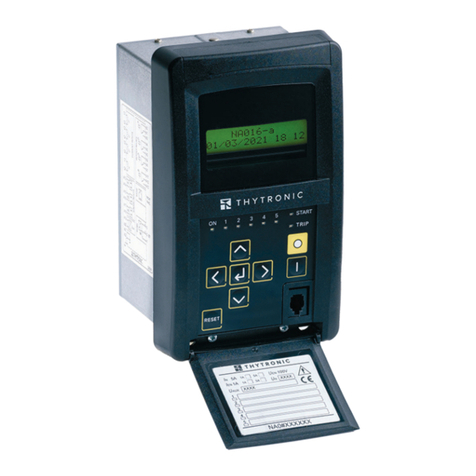
Thytronic
Thytronic NA011 User manual
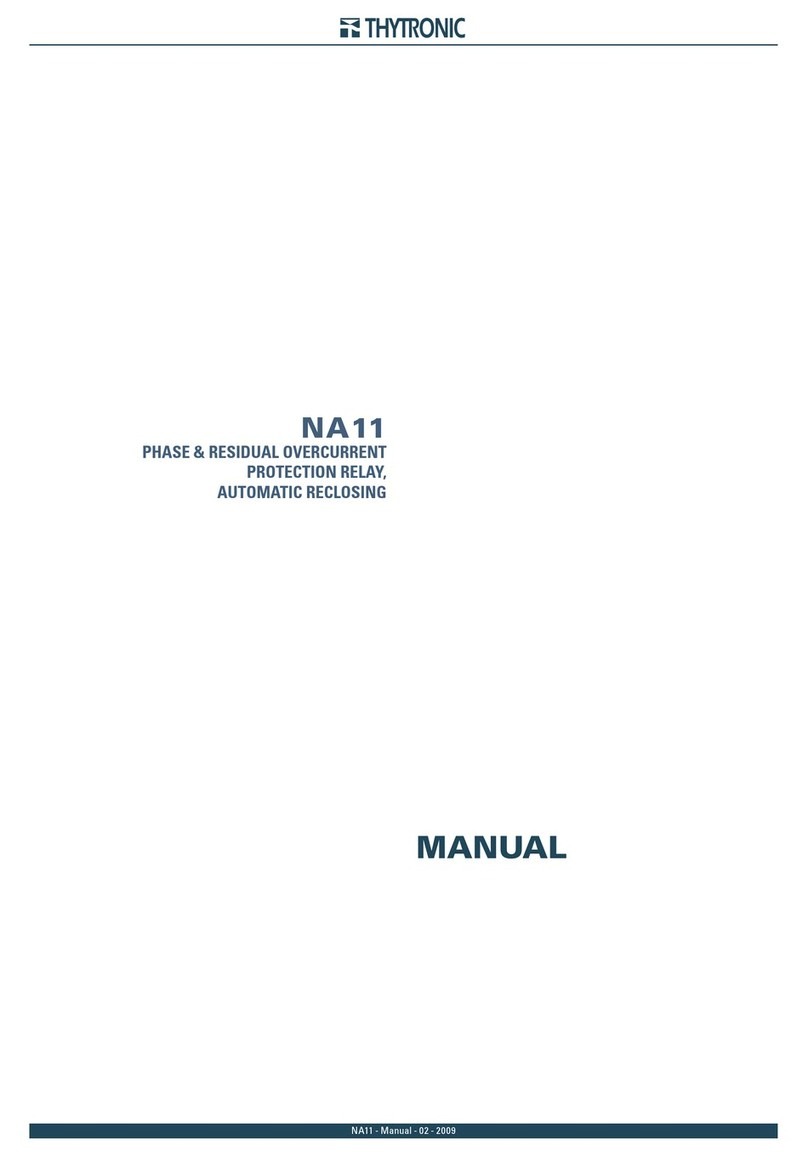
Thytronic
Thytronic NA11 User manual
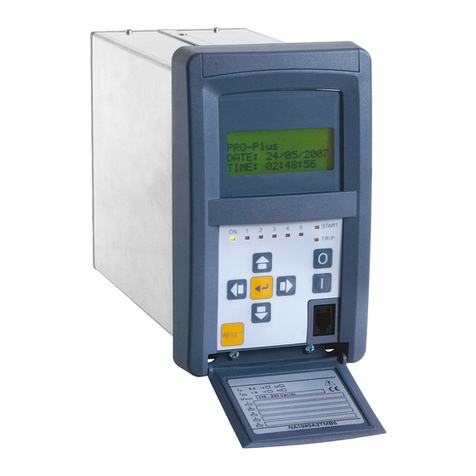
Thytronic
Thytronic NA30 User manual

Thytronic
Thytronic NA016 User manual
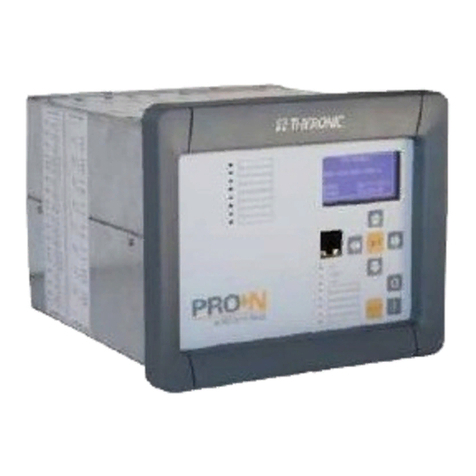
Thytronic
Thytronic NVA100X User manual

Thytronic
Thytronic NV021 User manual
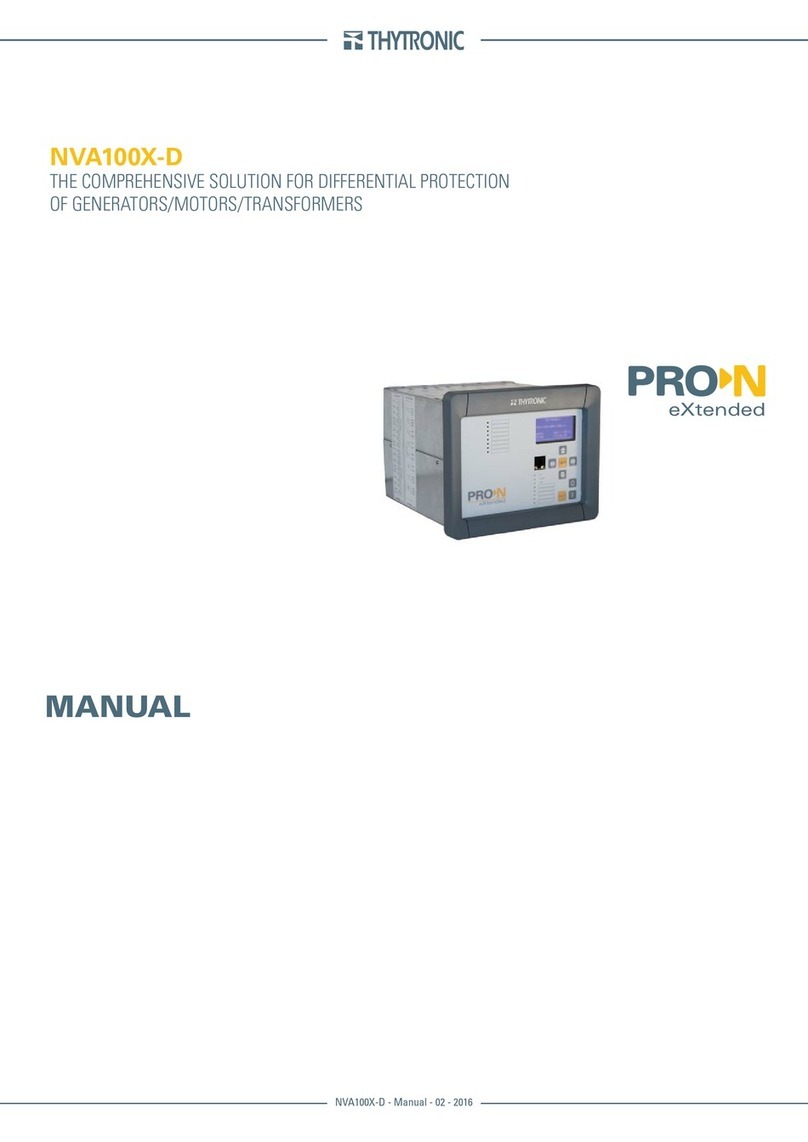
Thytronic
Thytronic Pro-N NVA100X-D User manual
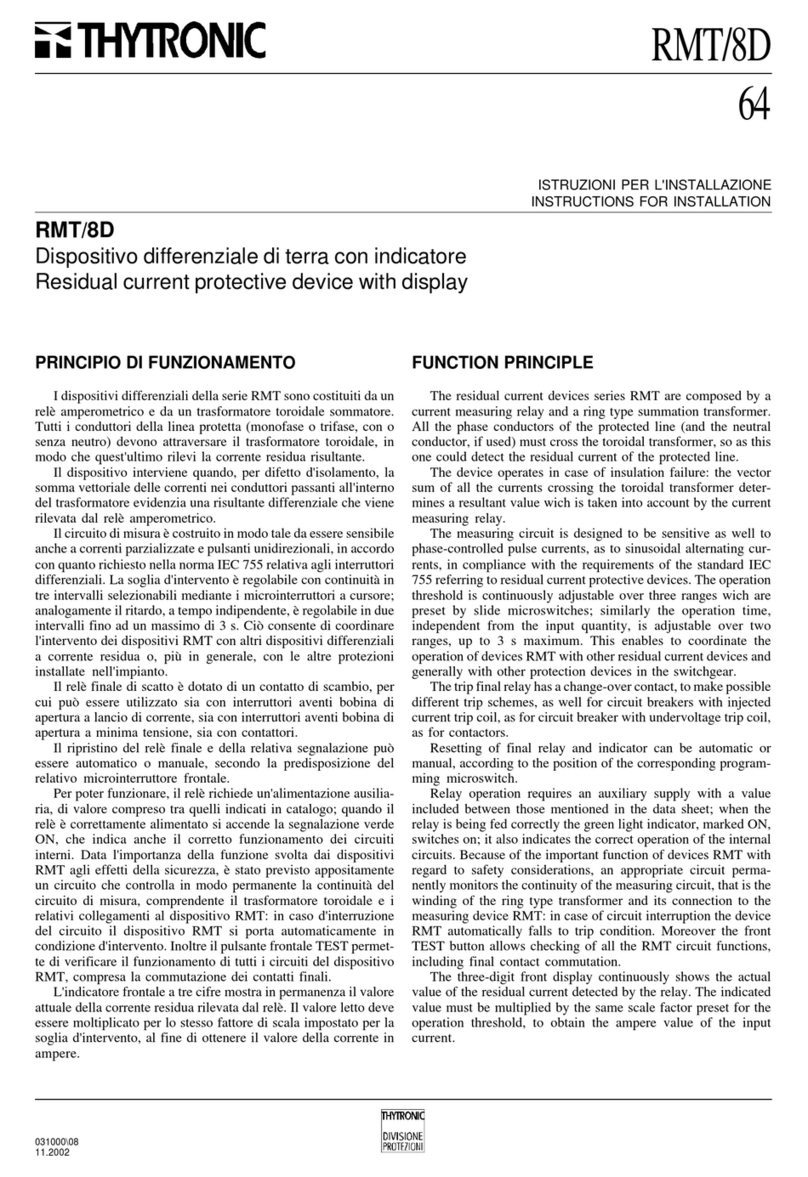
Thytronic
Thytronic RMT/8D Guide

Thytronic
Thytronic RMT/3 Guide

Thytronic
Thytronic DTB 49-50 User manual
